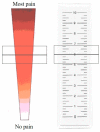Paediatric Pain Medicine: Pain Differences, Recognition and Coping Acute Procedural Pain in Paediatric Emergency Room
- PMID: 30486427
- PMCID: PMC6306713
- DOI: 10.3390/medicina54060094
Paediatric Pain Medicine: Pain Differences, Recognition and Coping Acute Procedural Pain in Paediatric Emergency Room
Abstract
Paediatric pain and its assessment and management are challenging for medical professionals, especially in an urgent care environment. Patients in a paediatric emergency room (PER) often undergo painful procedures which are an additional source of distress, anxiety, and pain. Paediatric procedural pain is often underestimated and neglected because of various myths, beliefs, and difficulties in its evaluation and treatment. However, it is very different from other origins of pain as it can be preventable. It is known that neonates and children can feel pain and that it has long-term effects that last through childhood into adulthood. There are a variety of pain assessment tools for children and they should be chosen according to the patient's age, developmental stage, communication skills, and medical condition. Psychological factors such as PER environment, preprocedural preparation, and parental involvement should also be considered. There are proven methods to reduce a patient's pain and anxiety during different procedures in PER. Distraction techniques such as music, videogames, virtual reality, or simple talk about movies, friends, or hobbies as well as cutaneous stimulation, vibration, cooling sprays, or devices are effective to alleviate procedural pain and anxiety. A choice of distraction technique should be individualized, selecting children who could benefit from nonpharmacological pain treatment methods or tools. Nonpharmacological pain management may reduce dosage of pain medication or exclude pharmacological pain management. Most nonpharmacological treatment methods are cheap, easily accessible, and safe to use on every child, so it should always be a first choice when planning a patient's care. The aim of this review is to provide a summary of paediatric pain features, along with their physiology, assessment, management, and to highlight the importance and efficacy of nonpharmacological pain management in an urgent paediatric care setting.
Keywords: acute pain; management; nonpharmacological; paediatric pain; pain assessment; procedural pain.
Conflict of interest statement
The authors declare no conflict of interest.
Figures
Similar articles
-
Is Virtual Reality Ready for Prime Time in the Medical Space? A Randomized Control Trial of Pediatric Virtual Reality for Acute Procedural Pain Management.J Pediatr Psychol. 2018 Apr 1;43(3):266-275. doi: 10.1093/jpepsy/jsx129. J Pediatr Psychol. 2018. PMID: 29053848 Clinical Trial.
-
Audiovisual distraction for pain relief in paediatric inpatients: A crossover study.Eur J Pain. 2017 Jan;21(1):178-187. doi: 10.1002/ejp.915. Epub 2016 Jul 26. Eur J Pain. 2017. PMID: 27461092 Clinical Trial.
-
Use of virtual reality in managing paediatric procedural pain and anxiety: An integrative literature review.J Clin Nurs. 2022 Nov;31(21-22):3032-3059. doi: 10.1111/jocn.16217. Epub 2022 Jan 23. J Clin Nurs. 2022. PMID: 35068011 Review.
-
Effectiveness of non-pharmacological measures for reducing pain and fear in children during venipuncture in the emergency department: a vibrating cold devices versus distraction.Emergencias. 2018 Jun;30(3):182-185. Emergencias. 2018. PMID: 29687673 Clinical Trial. English, Spanish.
-
Acute Pediatric Pain Management in the Primary Care Office.Pediatr Ann. 2018 Mar 1;47(3):e124-e129. doi: 10.3928/19382359-20180222-01. Pediatr Ann. 2018. PMID: 29538786 Review.
Cited by
-
Pain and pain management in children and adolescents receiving hospital care: a cross-sectional study from Sweden.BMC Pediatr. 2022 May 5;22(1):252. doi: 10.1186/s12887-022-03319-w. BMC Pediatr. 2022. PMID: 35513880 Free PMC article.
-
Effects of aromatherapy with Rosa damascene and lavender on pain and anxiety of burn patients: A systematic review and meta-analysis.Int Wound J. 2023 Aug;20(6):2459-2472. doi: 10.1111/iwj.14093. Epub 2023 Jan 18. Int Wound J. 2023. Retraction in: Int Wound J. 2025 Mar;22(3):e70246. doi: 10.1111/iwj.70246. PMID: 36651329 Free PMC article. Retracted.
-
Construction of an Evidence Ecosystem-Based Postoperative Pain Management Programme for Paediatric Patients.Nurs Open. 2025 Mar;12(3):e70167. doi: 10.1002/nop2.70167. Nurs Open. 2025. PMID: 40025841 Free PMC article.
-
Effectiveness of art-based distraction in reducing pain and anxiety of hospitalized children during cannulation procedure: A randomized controlled trial.Belitung Nurs J. 2022 Jun 28;8(3):213-221. doi: 10.33546/bnj.2054. eCollection 2022. Belitung Nurs J. 2022. PMID: 37547118 Free PMC article.
-
Virtual reality therapy in managing cancer pain in middle-aged and elderly: a systematic review and meta-analysis.PeerJ. 2024 Dec 13;12:e18701. doi: 10.7717/peerj.18701. eCollection 2024. PeerJ. 2024. PMID: 39686987 Free PMC article.
References
-
- IASPTerminology-IASP. [(accessed on 8 September 2018)]; Available online: http://www.iasp pain.org/Education/Content.aspx?ItemNumber=1698&navItemN....
-
- Wier L.M., Yu H., Owens P.L., Washington R. Overview of Children in the Emergency Department, 2010: Statistical Brief #157. [(accessed on 8 September 2018)];2013 Healthcare Cost and Utilization Project (HCUP) Statistical Briefs. Available online: https://www.ncbi.nlm.nih.gov/pubmed/24006551.
Publication types
MeSH terms
LinkOut - more resources
Full Text Sources
Medical



